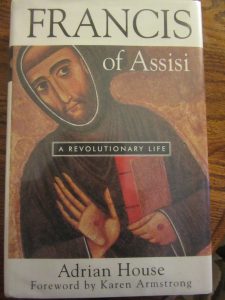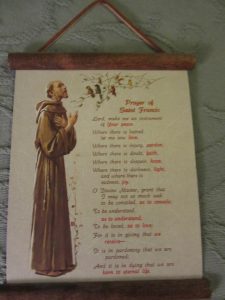A Review of "Francis of Assisi – A Revolutionary Life", by Adrian House
 This is a book I have long wanted to read. How long? Sixteen years. It’s been on my TBR list since I worked for our community’s start-up library and oversaw collection development. One of the perks of the job was to be able to buy some of the books I was interested in.
This is a book I have long wanted to read. How long? Sixteen years. It’s been on my TBR list since I worked for our community’s start-up library and oversaw collection development. One of the perks of the job was to be able to buy some of the books I was interested in.
My interest in St. Francis dates back before then. Intrigued by the cloistered life and fond of animals, I was drawn to this figure who preached to birds and founded a religious order. I’ve had the Prayer of St. Francis hanging on my bedroom wall for almost 20 years. In some ways, you could say I was a groupie, albeit a very ignorant one. 
Like countless others, I knew the story of a man who renounced his family’s great wealth and his partying ways, removed his clothes and took a vow of poverty, then went off to preach to birds. I had a lot to learn.
This book by Adrian House more than filled in the gaping holes in my knowledge; it did so in an entertaining and thought-provoking way. It is a dense book, filled with too many Italian names and places to keep straight, but as I kept with it, I was rewarded for my persistence. I continually came across insightful passages connecting Francis’s journey and thoughts to modern times or to other historical events.
The book is well written, weaving Francis’s story with the events and people of his day, fitting them into a broader context. It is also an irksome and irritating book, because while it educates you, it also points out your vast ignorance on many of these other topics. You begin to realize how much of the world’s history you do not know, and while you’re grateful for this piece, you become more aware of the enormity of the iceberg beneath your feet.
Adrian House depicts a man who is full of life, charm, seemingly blessed by worldly gifts of money, position, friends, yet who trades these worldly gifts for the example of Christ, poverty, grace, submission to authority and complete dependence upon God.
The author posits that one of Francis’s main driving forces was his love for the troubadour ideal, to become a knight in the tradition of King Arthur, but was convinced by God to seek the true King instead. God revealed his true love, faithfulness and obedience and the pinnacle of courtly love given to the true and perfect King. In his words, “In his head the archetype of chivalry first fought with, and were then replaced by, those of the Christian religion.”
The new main driving force of Francis’s life was his goal of living a life following the example of Christ as presented in the gospels. When he petitioned the Pope for the creation of a new order, although there was suspicion and mistrust for this new and hard way of living, church leaders ultimately recognized God’s hand, by saying
“We must be careful. If we refuse this beggar’s request, on the grounds that it is new, or that we think it too difficult for his followers, we may be committing a sin, because he is only asking us to approve a form of gospel life. Anyone who says this is unreasonable is guilty of blasphemy against Christ, for he is the author of it.”
I came away with a better knowledge of the key tenants of Francis’s Order: namely poverty, the complete stricture against owning property or goods beyond a simple robe, the refusal to accept money, but to gratefully receive any alms given in the way of food or shelter, the need to work with one’s hands, to devote oneself to prayer and to strive to live a life free of sin. There is also a strong emphasis on obedience to church officers and we see this played out in Francis’s obedience to the Pope and other church leaders.
We also see how Francis struggled with the growth of his Order, as well as his Second Order for women, founded by St. Clare and known as the Poor Clares, and his Third Order for lay people who shared his ideals but found they could not make or keep vows of poverty or separation. This group, initially called the Brothers and Sisters of Penance and sometimes known as the teriaries, grew to include large numbers of influential people including Leonardo da Vinci, Dante, Columbus, and Galileo.
Identifying fully with the humanity of Christ, Francis focused on the Christmas story, creating the first live nativity scenes, and on the crucifixion of Christ, becoming the first in known history to exhibit the stigmata, or crucifixion wounds on hands, feet, and side. Here House explores possible medical causes for such wounds, while not discounting spiritual ones. The book ends with a look at Francis’s order following his death, depicting changes and honors that Francis would have abhorred and fought against.
My personal takeaway from his story is that I could not live the life Francis was called to live, but the idealist in me is attracted to it. To put God before physical comfort, before peace and ease, is a difficult concept for my comfort-loving self. I want the peace Francis felt, but not the selflessness that makes it possible. However, this book called me to look at the fundamentals, the most important things in my life. I invite you to do the same. I suspect you will find that the most important things are not things at all, but people, ideas, moments and experiences. Perhaps it’s not so difficult to give away your possessions if you look at them that way.
Finally, I found that the writer and reader of historical fiction in me was left wanting more. I began to wonder if there are fictional accounts of St. Francis, St. Clare and others in the book. I saw possibilities for stories littered all over the pages. Take, for example, this short snippet describing one of the early tertiaries:
“Lucchesio da Siena had known Francis when they were both young and had then grown rich by cornering the grain market, from which he made exorbitant profits until civil war drove him and his wife, Buonadonna, to Poggibonsi. There they took pity on the victims of the fighting and distributed everything they owned to the worst hit. After that Lucchesio slaved for the rest of his life to pay for medicines and food when took around to the sick on his donkey.”
Do you not see the potential for a book right there? So, in the end, one book left my TBR pile, but I suspect several others will be added. Who knows, perhaps another one has been added to my to-be-written pile as well.
In the mean time, I leave you with the famous Prayer of Saint Francis and encourage you to try to incorporate a little of his spirit into your life. I know I will.
Lord, make me an instrument of your peace.
Where there is hatred, let me bring love.
Where there is offense, let me bring pardon.
Where there is discord, let me bring union.
Where there is error, let me bring truth.
Where there is doubt, let me bring faith.
Where there is despair, let me bring hope.
Where there is darkness, let me bring your light.
Where there is sadness, let me bring joy.
O Master, let me not seek as much
to be consoled as to console,
to be understood as to understand,
to be loved as to love,
for it is in giving that one receives,
it is in self-forgetting that one finds,
it is in pardoning that one is pardoned,
it is in dying that one is raised to eternal life.

























